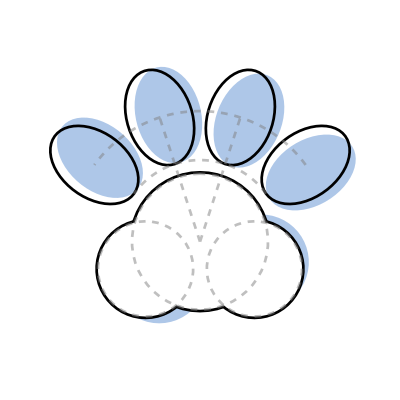Modifier
Modifier is a function that modifies a Diagram. It takes a Diagram as input, and returns a Diagram as output.
Modifier can be applied to a Diagram using the
Diagram.apply method.
// `Diagram.apply` takes any function that takes a Diagram as input and returns a Diagram as output
// but diagramatics also provides built-in modifier functions that can be used
Diagram.apply (
modifier_function
:
(d : Diagram) => Diagram )
:
Diagram
// `Diagram.apply` takes any function that takes a Diagram as input and returns a Diagram as output
// but diagramatics also provides built-in modifier functions that can be used
*
Diagram.apply only apply the function to the outermost diagram. If you want to apply the function recursively, you can use
Diagram.apply_recursive.
// Subdivide each segment of a diagram into `n` segments
let pent = regular_polygon(5, 5).apply(mod.subdivide(3));
draw(pent.debug());
mod.subdivide (
n
:
number )
:
modifierFunction
// Subdivide each segment of a diagram into `n` segments
let pent = regular_polygon(5, 5).apply(mod.subdivide(3));
draw(pent.debug());
// Resample a diagram so that it has `n` points
let pent = regular_polygon(5, 5).apply(mod.resample(10));
draw(pent.debug());
mod.resample (
n
:
number )
:
modifierFunction
// Resample a diagram so that it has `n` points
let pent = regular_polygon(5, 5).apply(mod.resample(10));
draw(pent.debug());
let pent = regular_polygon(5, 5).apply(mod.resample(100));
draw(pent.debug());
let pent = regular_polygon(5, 5).apply(mod.resample(100));
draw(pent.debug());
If
n is not a multiple of the number of points, the path will be distorted.
In some cases it might be better to use
mod.subdivide instead.
// if the sampling point is too small or not a multiple of the number of points
// the path will be distorted
let pent = regular_polygon(5, 5).apply(mod.resample(8));
draw(pent.debug());
// if the sampling point is too small or not a multiple of the number of points
// the path will be distorted
let pent = regular_polygon(5, 5).apply(mod.resample(8));
draw(pent.debug());
// Modifies a diagram by rounding the corners of a polygon or curve
// `radius` : radius of the corner
// `point_indices` : indices of the points to be rounded
// * if `point_indices` is not provided, all the points will be rounded
// you can check the index of the point by using the `Diagram.debug` method
let sq = square(5).apply(mod.round_corner(2, [0,2]));
draw(sq);
mod.round_corner (
radius
:
number | number[] , point_indices?
:
number[] , count?
:
number = 40 )
:
modifierFunction
// Modifies a diagram by rounding the corners of a polygon or curve
// `radius` : radius of the corner
// `point_indices` : indices of the points to be rounded
// * if `point_indices` is not provided, all the points will be rounded
// you can check the index of the point by using the `Diagram.debug` method
let sq = square(5).apply(mod.round_corner(2, [0,2]));
draw(sq);
// Add an arrow to the end of a curve
// Make sure the diagram this modifier is applied to is a curve
// `headsize` : size of the arrow head
// `flip` : flip the arrow position
let curve = graph.plotf(x => Math.sin(x));
let with_arrow = curve.apply(mod.add_arrow(0.2)).fill('blue');
draw(with_arrow);
mod.add_arrow (
headsize
:
number , flip?
:
boolean = false )
:
modifierFunction
// Add an arrow to the end of a curve
// Make sure the diagram this modifier is applied to is a curve
// `headsize` : size of the arrow head
// `flip` : flip the arrow position
let curve = graph.plotf(x => Math.sin(x));
let with_arrow = curve.apply(mod.add_arrow(0.2)).fill('blue');
draw(with_arrow);
// Replace arrowhead inside a diagram with another diagram
// The arrow will be rotated automatically
// The default direction is to the right (+x) with the tip at the origin
let diamond = regular_polygon(4).move_origin('center-right').fill('blue');
let arr = arrow(V2(10,0)).apply(mod.arrowhead_replace(diamond));
draw(arr);
mod.arrowhead_replace (
new_arrowhead
:
Diagram )
:
modifierFunction
// Replace arrowhead inside a diagram with another diagram
// The arrow will be rotated automatically
// The default direction is to the right (+x) with the tip at the origin
let diamond = regular_polygon(4).move_origin('center-right').fill('blue');
let arr = arrow(V2(10,0)).apply(mod.arrowhead_replace(diamond));
draw(arr);
let d = square(0.4).skewX(1).move_origin('bottom-right').fill('blue');
let ax = axes_empty().apply(mod.arrowhead_replace(d));
draw(ax);
let d = square(0.4).skewX(1).move_origin('bottom-right').fill('blue');
let ax = axes_empty().apply(mod.arrowhead_replace(d));
draw(ax);
Apply recursively
let p3 = regular_polygon(3);
let p4 = regular_polygon(4);
let p5 = regular_polygon(5);
let p6 = regular_polygon(6);
let group = distribute_grid_row([p3,p4,p5,p6], 2, 1, 1);
let rounded_group = group.apply_recursive(mod.round_corner(0.1))
draw(rounded_group);
Diagram.apply_recursive (
modifier_function
:
(d : Diagram) => Diagram )
:
Diagram
let p3 = regular_polygon(3);
let p4 = regular_polygon(4);
let p5 = regular_polygon(5);
let p6 = regular_polygon(6);
let group = distribute_grid_row([p3,p4,p5,p6], 2, 1, 1);
let rounded_group = group.apply_recursive(mod.round_corner(0.1))
draw(rounded_group);
